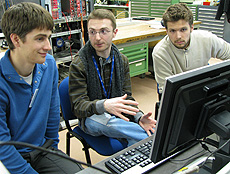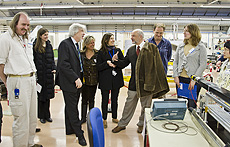School takes hands-on approach to particle detectors
 |
|
CERN's Marco Villa, center, explains to EDIT students Peter-Bernd Otte, left, and Tom Barber, right, how to use a gas electron multiplier detector. Photo by Kathryn Grim
|
Employees wandering the halls of CERN early this month overheard some unusual exchanges: teachers encouraging students to break their equipment.
Eighty-eight students attended EDIT2011, the Excellence in Detectors and Instrumentation Technologies school. They had a unique opportunity to hold, manipulate and sometimes destroy sensitive devices usually buried out of reach in the centers of multi-ton particle detectors.
In a laboratory dedicated to silicon detectors, teachers challenged students to break diminutive wire connections with a needle.
“The needle looked massive through the microscope lens,” said Aria Soha, Fermilab’s Test Beam Facility manager, who attended the school. “I felt like Godzilla. But it really showed you how sensitive the detectors are.”
Particle physics experiments today require complicated machines that scientists design and build over the course of decades. These timelines pose problems for students trying to understand the inner workings of the detectors they use.
“When I was a student, experiments consisted of a small group of people,” said CERN physicist Ariella Cattai, director of the EDIT school. “We built, assembled and tested equipment ourselves.”
EDIT2011 is the first school in high-energy physics dedicated to giving students hands-on experiences with cutting-edge technology. More than 250 people applied. Accepted students traveled to CERN from 26 countries, and more than one third were women.
About 110 experts from 13 countries lectured or gave the students almost individual attention during labs over the course of two weeks.
Both Fermilab Director Pier Oddone and CERN Director-General Rolf Heuer said they were impressed with the school after touring some of the labs. Oddone supported the idea of hosting its next iteration at Fermilab.
“I think this fills a need,” Oddone said. “We should almost make it a necessary condition of getting your Ph.D.”
-- Kathryn Grim
 |
|
Fermilab Director Pier Oddone and CERN Director-General Rolf Heuer visit students in an EDIT lab. Photo courtesy of CERN
|
|